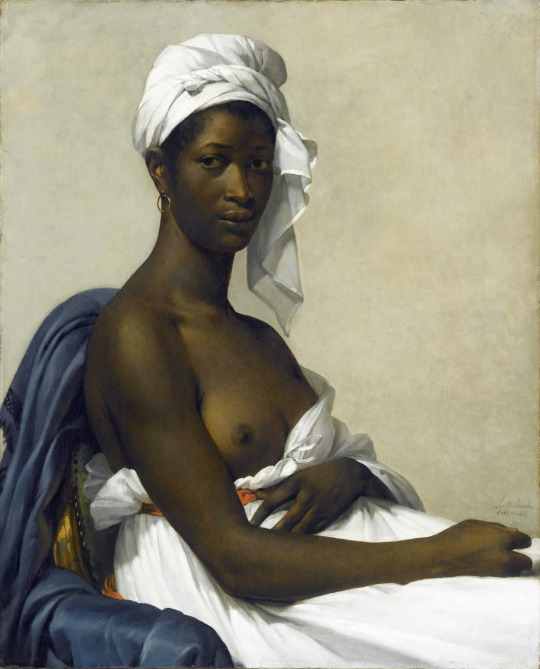#formerly known as Portrait of a Negress
Explore tagged Tumblr posts
Text

Portrait of Madeleine (1800) by Marie-Guillemine Benoist
Marie-Guillemine Benoist's training as an artist began in 1781 under Élisabeth Vigée Le Brun. She entered Jacques-Louis David's atelier in 1786.
Madeleine, transported from the island of Guadeloupe to France by the artist's brother-in-law, is believed to have been born a slave in the colony and subsequently freed by the 1794 decree (abolition of slavery in French colonies and the mainland). Her exact status remains unclear. Regardless of whether she came to France as a slave or a servant, her influence on how Benoist portrayed her would have been limited, unlike the women who typically commissioned their portraits.
(more info about the artist and the sitter)
#Portrait of Madeleine#formerly known as Portrait of a Negress#1800s#Marie Guillemine Benoist#art#painting#Miss Cromwell#1800#portrait
45 notes
·
View notes
Text

Artiste: Marie-Guillemine Benoist
Titre: Portait d’une femme noire
Portrait d'une femme noire anciennement dénommé Portrait d'une négresse est un tableau de la peintre française Marie-Guillemine Benoist, élève de Jacques-Louis David, réalisée en 1800. Cette huile sur toile est un portrait d'une jeune femme noire considéré comme une célébration de l'abolition de l'esclavage dans les colonies par la Révolution française.
Acquise en 1818, cette œuvre est conservée au Musée du Louvre, à Paris.
Source: Wiki Art
Marie-Guillemine Benoist’s Portrait of Madeleine (formerly known as Portrait of a Negress) hangs today in the Louvre in a gallery devoted to paintings by Jacques-Louis David and his students. It is placed at the center of a wall displaying seven portraits, a location that asserts its importance. In 1800 the work was exhibited in the Louvre for the first time, at the Salon—the state-sponsored presentation of works by contemporary artists. It hung in the Salon Carré, one smallish work on a wall of paintings hung frame to frame, floor to ceiling, as was customary at the time. Contemporary art critics picked it out, but not all were impressed. The critic for a conservative paper derided it as a “noirceur” or “black stain.” Why did this work provoke such a negative response when first exhibited?
Link: smarthistory
#œuvre d’art#artist#art moderne#madeleine#Marie Guillemine Benoist#french#europe#femme noire#black art#black women#painting#art#art visuel
4 notes
·
View notes